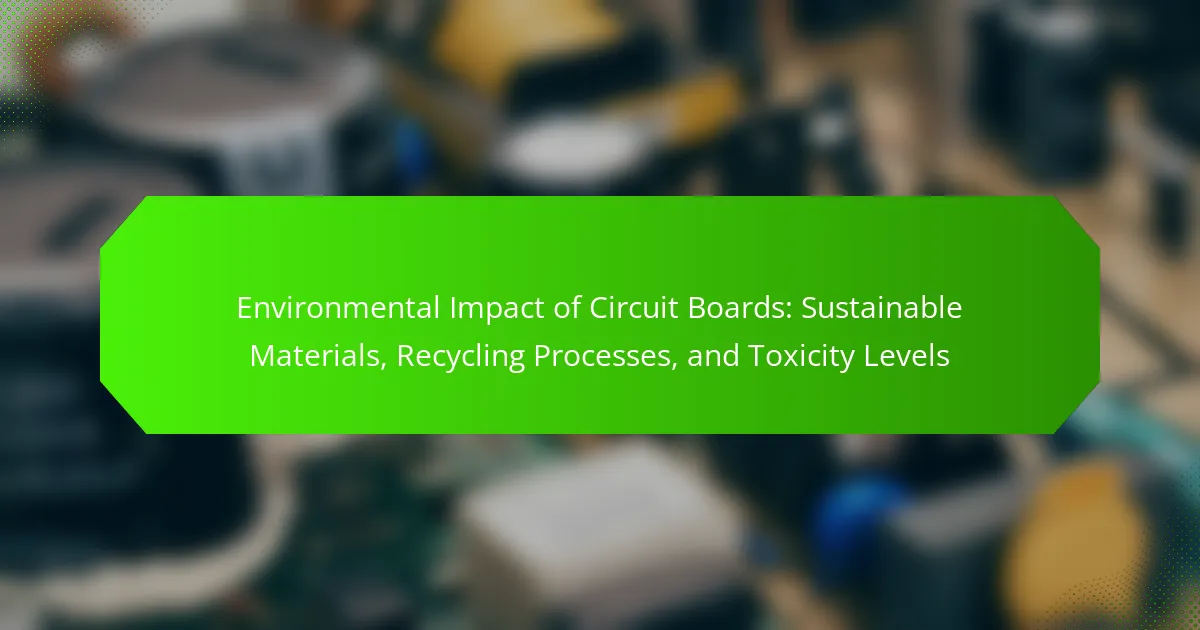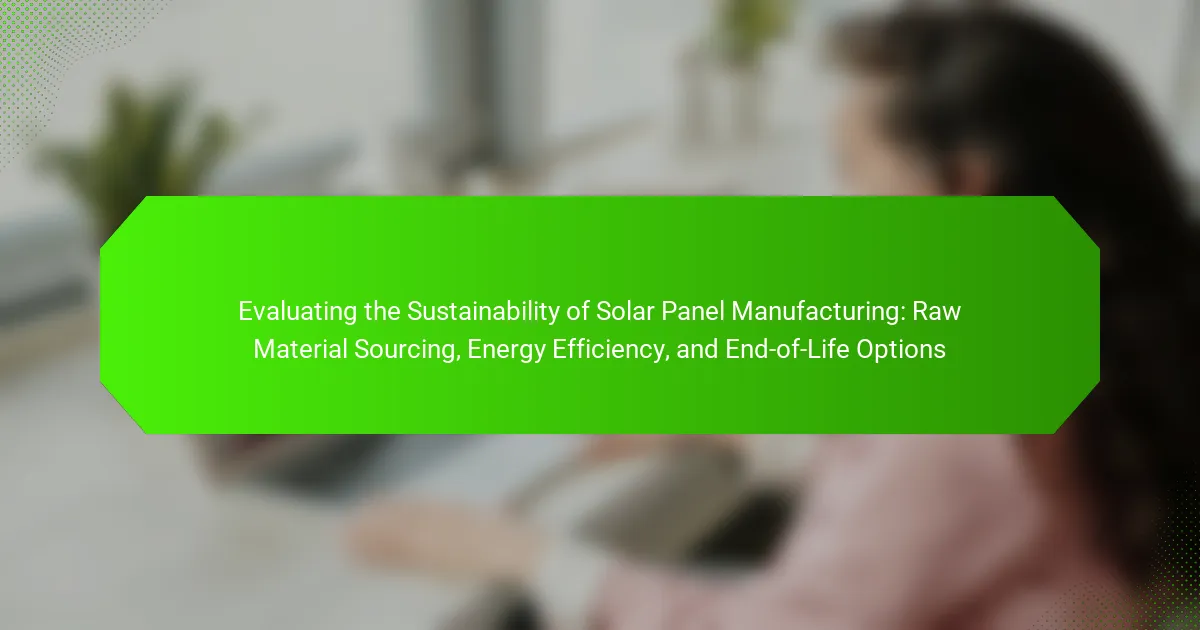Circuit boards are electronic components that significantly impact the environment due to their hazardous materials and disposal methods. Composed of toxic substances like lead, mercury, and cadmium, improper disposal can lead to soil and groundwater contamination, posing risks to ecosystems and human health. The manufacturing of circuit boards is resource-intensive, consuming large amounts of energy and water while generating waste and emissions. Although recycling can alleviate some environmental concerns by recovering valuable materials, only about 20% of electronic waste is currently recycled globally. Future sustainability trends focus on eco-friendly materials, advanced recycling technologies, and design for disassembly to reduce the environmental footprint of circuit boards.

What is the Environmental Impact of Circuit Boards?
Circuit boards have a significant environmental impact due to their composition and disposal methods. They often contain hazardous materials like lead, mercury, and cadmium. When circuit boards are improperly disposed of, these toxic substances can leach into soil and groundwater. This contamination poses risks to ecosystems and human health.
The production of circuit boards also contributes to environmental degradation. Manufacturing processes consume large amounts of energy and water. They generate substantial waste and emissions, further harming the environment. Recycling circuit boards can mitigate some of these impacts. Effective recycling processes recover valuable materials and reduce landfill waste.
However, many electronic devices are not recycled properly. It is estimated that only 20% of electronic waste is recycled globally. This low recycling rate exacerbates the environmental issues associated with circuit boards. Thus, the environmental impact of circuit boards is multi-faceted, involving both toxic material risks and resource-intensive production methods.
How do circuit boards contribute to environmental issues?
Circuit boards contribute to environmental issues primarily through electronic waste and toxic materials. They often contain hazardous substances such as lead, mercury, and cadmium. When improperly disposed of, these materials can leach into soil and water systems. This contamination poses risks to human health and ecosystems. Additionally, the production of circuit boards involves significant energy consumption and resource extraction. This process contributes to carbon emissions and depletes natural resources. According to the United Nations, e-waste generated globally reached 53.6 million metric tons in 2019. Only 17.4% of this was recycled properly, exacerbating environmental challenges.
What are the primary environmental concerns associated with circuit board production?
The primary environmental concerns associated with circuit board production include toxic chemical use, electronic waste, and resource depletion. Toxic chemicals such as lead, mercury, and brominated flame retardants are used in manufacturing. These substances can leach into soil and water, posing risks to human health and ecosystems. Electronic waste generated from discarded circuit boards contributes to landfill overflow and pollution. The extraction of raw materials for circuit boards depletes natural resources and can lead to habitat destruction. According to the United Nations, around 50 million tons of electronic waste is generated globally each year, highlighting the scale of the issue.
How does the disposal of circuit boards affect the environment?
The disposal of circuit boards negatively impacts the environment. Circuit boards contain hazardous materials such as lead, mercury, and cadmium. When improperly disposed of, these toxins can leach into soil and water. This contamination poses risks to ecosystems and human health. E-waste, including circuit boards, contributes to growing landfill volumes. According to the Global E-waste Monitor 2020, 53.6 million metric tons of e-waste were generated globally. Only 17.4% of this waste was recycled, highlighting the need for better disposal practices. Proper recycling can mitigate these environmental effects. Recycling processes recover valuable materials and prevent toxic substances from entering the environment.
What role do sustainable materials play in circuit board manufacturing?
Sustainable materials play a crucial role in circuit board manufacturing by reducing environmental impact. These materials minimize the use of toxic substances, which are prevalent in traditional circuit boards. For example, using bio-based resins instead of petroleum-based options lowers carbon emissions. Additionally, sustainable materials often enhance recyclability, making end-of-life processing more efficient. Research indicates that circuit boards made from sustainable materials can decrease landfill waste by up to 30%. This shift towards sustainability also encourages innovation in manufacturing processes. Overall, integrating sustainable materials leads to a healthier ecosystem and supports regulatory compliance in many regions.
Which sustainable materials are commonly used in circuit boards?
Sustainable materials commonly used in circuit boards include bio-based epoxy resins, paper phenolic laminates, and recycled glass fiber. Bio-based epoxy resins are derived from plant materials and reduce reliance on petroleum-based products. Paper phenolic laminates, made from cellulose fibers, offer a biodegradable alternative to traditional materials. Recycled glass fiber minimizes waste and utilizes existing resources. These materials contribute to reducing the environmental impact of circuit board production. Their use aligns with sustainability goals in electronics manufacturing.
What are the benefits of using sustainable materials in circuit boards?
Sustainable materials in circuit boards reduce environmental impact. They minimize waste generation during production. These materials often come from renewable sources, decreasing reliance on finite resources. Using sustainable materials can lower carbon emissions associated with manufacturing. They also enhance recyclability, making end-of-life processing easier. According to a study by the University of Cambridge, sustainable materials can reduce energy consumption by up to 30% in production processes. Additionally, they often contain fewer harmful substances, improving safety for workers and consumers. Overall, the use of sustainable materials supports a circular economy in electronics.
How can recycling processes mitigate the environmental impact of circuit boards?
Recycling processes can significantly mitigate the environmental impact of circuit boards. They recover valuable materials like gold, copper, and rare earth elements. This reduces the need for mining, which is environmentally destructive. Recycling also minimizes electronic waste in landfills, where circuit boards can leach toxic substances. According to the United Nations, e-waste is expected to reach 74 million metric tons by 2030. Proper recycling can prevent harmful chemicals from contaminating soil and water. Additionally, recycling lowers greenhouse gas emissions compared to producing new materials. The Environmental Protection Agency states that recycling can save energy equivalent to powering millions of homes.
What are the common recycling methods for circuit boards?
Common recycling methods for circuit boards include mechanical recycling, pyrometallurgical recycling, and hydrometallurgical recycling. Mechanical recycling involves shredding the circuit boards to separate metals from non-metals. This method efficiently recovers copper and other valuable metals. Pyrometallurgical recycling uses high temperatures to melt the circuit boards. This process allows for the extraction of precious metals like gold and silver. Hydrometallurgical recycling employs chemical solutions to dissolve metals from circuit boards. It is effective for recovering metals while minimizing environmental impact. Each method has its own advantages and is chosen based on the specific materials present in the circuit boards.
How effective are these recycling processes in reducing waste?
Recycling processes are highly effective in reducing waste. They can divert up to 90% of electronic waste from landfills. For circuit boards, recycling recovers valuable materials like gold and copper. This process conserves natural resources and reduces environmental pollution. A study by the United Nations University found that recycling electronic waste can prevent significant greenhouse gas emissions. Effective recycling also minimizes the need for new raw materials, which often involve environmentally damaging extraction processes. Therefore, recycling processes play a crucial role in waste reduction and environmental sustainability.

What are the toxicity levels associated with circuit boards?
Circuit boards can exhibit varying toxicity levels depending on their materials. Common toxic substances found in circuit boards include lead, brominated flame retardants, and cadmium. Lead is particularly concerning, as it can leach into the environment and pose health risks. Studies indicate that lead levels can reach up to 1,000 parts per million in some boards. Brominated flame retardants are known to release harmful compounds during incineration. Cadmium, though less common, is still present in certain components and can be toxic to aquatic life. The toxicity of circuit boards emphasizes the need for proper recycling and disposal methods to mitigate environmental impact.
What toxic substances are found in circuit boards?
Circuit boards contain several toxic substances. Common toxic materials include lead, which is used in solder. Cadmium is another hazardous element found in some circuit boards. Brominated flame retardants, used for fire resistance, are also toxic. Mercury may be present in certain components. Additionally, polyvinyl chloride (PVC) is often used in insulation and can release harmful chemicals when burned. These substances can pose risks to human health and the environment. The presence of these toxins necessitates proper disposal and recycling methods to mitigate their impact.
How do these toxic substances affect human health and the environment?
Toxic substances from circuit boards adversely affect human health and the environment. These substances include heavy metals like lead and mercury. Exposure to lead can cause neurological damage, particularly in children. Mercury exposure can lead to kidney damage and neurological disorders.
In the environment, these toxic substances can contaminate soil and water. They can accumulate in the food chain, impacting wildlife and human health. For instance, lead contamination in water sources can result from improper disposal of circuit boards.
Research indicates that e-waste, including circuit boards, contributes significantly to global heavy metal pollution. According to a study published in the journal “Environmental Science & Technology,” improper recycling practices release harmful substances into the environment. This underscores the need for sustainable recycling processes to mitigate these health risks.
What regulations exist to control toxic materials in circuit boards?
Regulations that control toxic materials in circuit boards include the Restriction of Hazardous Substances (RoHS) Directive in the European Union. RoHS limits the use of specific hazardous materials in electrical and electronic equipment. These materials include lead, mercury, cadmium, hexavalent chromium, polybrominated biphenyls (PBB), and polybrominated diphenyl ethers (PBDE). Compliance with RoHS is mandatory for manufacturers selling products in the EU market. Additionally, the Waste Electrical and Electronic Equipment (WEEE) Directive mandates proper disposal and recycling of electronic waste. The U.S. has similar regulations, such as the Toxic Substances Control Act (TSCA), which addresses the safety of chemicals used in electronic products. These regulations aim to reduce environmental impact and protect public health.
How can consumers and manufacturers reduce toxicity in circuit boards?
Consumers and manufacturers can reduce toxicity in circuit boards by using eco-friendly materials and processes. Manufacturers should prioritize lead-free solder and halogen-free laminates. These materials significantly lower the release of harmful substances. Consumers can opt for products certified by environmental standards, such as RoHS. This certification indicates compliance with restrictions on hazardous substances. Additionally, manufacturers can implement closed-loop recycling systems. These systems reclaim materials from old circuit boards. This reduces the need for virgin materials and minimizes waste. By adopting these practices, both parties contribute to a safer environment.
What best practices can be adopted by manufacturers to minimize toxicity?
Manufacturers can adopt several best practices to minimize toxicity in circuit board production. Utilizing non-toxic materials is essential. This includes selecting lead-free solder and halogen-free laminates. Implementing closed-loop systems reduces waste and prevents toxic substances from entering the environment. Regularly conducting toxicity assessments ensures compliance with safety standards. Training employees on safe handling practices minimizes accidental exposure to harmful substances. Collaborating with suppliers who prioritize sustainability further enhances material safety. According to a study by the International Journal of Environmental Research and Public Health, these practices significantly reduce harmful emissions during production.
How can consumers make informed choices regarding circuit board products?
Consumers can make informed choices regarding circuit board products by researching materials and sustainability practices. Understanding the types of materials used in circuit boards is essential. Common materials include FR-4, which contains epoxy resin and glass fiber. Eco-friendly alternatives, such as biodegradable substrates, are available.
Consumers should also investigate manufacturers’ recycling processes. Companies that offer take-back programs or recycling options demonstrate a commitment to sustainability. Checking for certifications, like RoHS compliance, indicates adherence to environmental standards.
Reading reviews and expert opinions can provide insight into product quality and environmental impact. Comparing products based on their toxicity levels is crucial. Resources like the Electronic Industry Citizenship Coalition (EICC) provide guidelines on responsible sourcing.
By prioritizing these factors, consumers can select circuit board products that align with their values and contribute to environmental sustainability.

What future trends are shaping the sustainability of circuit boards?
Future trends shaping the sustainability of circuit boards include the adoption of eco-friendly materials, advanced recycling technologies, and design for disassembly. Eco-friendly materials such as biodegradable substrates and non-toxic solder are gaining traction. Advanced recycling technologies enable efficient recovery of valuable metals and components. Design for disassembly allows easier repairs and recycling, extending product life. These trends are driven by increasing regulatory pressures and consumer demand for sustainable electronics. Research indicates that using alternative materials can significantly reduce environmental impact. For instance, a study by the International Journal of Electronics found that biodegradable materials can decrease waste by up to 30%.
How is technology evolving to improve circuit board sustainability?
Technology is evolving to improve circuit board sustainability through advancements in materials and recycling processes. Innovations include the development of biodegradable substrates, such as cellulose-based materials, which reduce environmental impact. Additionally, manufacturers are adopting lead-free soldering techniques to minimize toxic substances.
Recycling processes are becoming more efficient with the use of automated systems that can recover valuable metals from discarded boards. For instance, hydrometallurgical methods are being implemented to extract metals like gold and copper without harmful chemicals.
Research shows that these advancements can significantly lower the carbon footprint of circuit boards. A study by the International Journal of Environmental Science and Technology indicates that sustainable materials can reduce energy consumption during production by up to 30%.
Overall, technology is driving significant changes toward more sustainable circuit board manufacturing and disposal practices.
What innovations are being developed to enhance recycling processes?
Innovations in recycling processes include advanced sorting technologies, chemical recycling methods, and automated systems. Advanced sorting technologies utilize AI and machine learning to improve material separation accuracy. This leads to higher quality recycled materials. Chemical recycling methods break down plastics into their original monomers for reuse. This process can handle contaminated or mixed plastics effectively. Automated systems streamline the recycling process, reducing labor costs and increasing throughput. These innovations are crucial as they address the growing volume of electronic waste, particularly circuit boards. In 2021, the global e-waste recycling market was valued at approximately $49.5 billion, highlighting the need for improved recycling methods.
How are manufacturers adapting to emerging sustainability standards?
Manufacturers are adapting to emerging sustainability standards by integrating eco-friendly materials into their production processes. They are increasingly using biodegradable and recyclable materials in circuit board manufacturing. This shift helps reduce environmental impact and aligns with new regulations. Many companies are also investing in advanced recycling technologies. These technologies enable the recovery of valuable materials from electronic waste. Furthermore, manufacturers are implementing life cycle assessments. This practice evaluates the environmental impacts of products from creation to disposal. In 2021, over 60% of electronics manufacturers reported compliance with sustainability standards. This trend reflects a growing commitment to environmental responsibility.
What practical steps can be taken to promote sustainable circuit board use?
Implementing sustainable circuit board use involves several practical steps. First, manufacturers should prioritize eco-friendly materials. These materials reduce toxicity and environmental impact. Next, adopting design for recycling principles is crucial. This ensures easier disassembly and material recovery. Additionally, promoting the use of lead-free solder is essential. Lead-free options minimize harmful substances in waste. Encouraging manufacturers to establish take-back programs can facilitate recycling. These programs allow consumers to return old circuit boards for proper disposal. Lastly, raising awareness about sustainable practices among consumers is vital. Educated consumers are more likely to choose eco-friendly products. Collectively, these steps contribute to a more sustainable approach to circuit board usage.
How can businesses implement sustainable practices in circuit board production?
Businesses can implement sustainable practices in circuit board production by using eco-friendly materials. They can opt for biodegradable substrates instead of traditional plastics. Additionally, companies should minimize waste during the manufacturing process. This can be achieved through efficient production techniques and recycling scrap materials.
Investing in energy-efficient machinery is crucial. This reduces energy consumption and lowers carbon emissions. Implementing a closed-loop system can also help in reusing chemicals and materials. Furthermore, businesses should ensure proper disposal and recycling of electronic waste.
According to a study by the International Journal of Electronics, sustainable practices can reduce production costs by up to 30%. This shows that sustainability can be economically beneficial.
What role does consumer awareness play in promoting sustainability in circuit boards?
Consumer awareness plays a crucial role in promoting sustainability in circuit boards. Informed consumers demand eco-friendly products and practices. This demand encourages manufacturers to adopt sustainable materials and processes. Increased awareness leads to greater scrutiny of companies’ environmental practices. Consumers are more likely to support brands that prioritize sustainability. Research indicates that 66% of global consumers are willing to pay more for sustainable brands. As awareness grows, companies face pressure to innovate and reduce waste. Ultimately, consumer choices drive the market towards sustainable circuit board solutions.
The main entity of this article is circuit boards, which have a significant environmental impact due to their composition, production processes, and disposal methods. The article examines the hazardous materials found in circuit boards, such as lead and mercury, and the risks they pose to human health and ecosystems when improperly disposed of. It highlights the importance of recycling and the use of sustainable materials to mitigate these impacts, as well as the low global recycling rates of electronic waste. Additionally, the article discusses emerging trends and best practices for reducing toxicity in circuit board manufacturing, emphasizing the role of consumer awareness in promoting sustainability.


